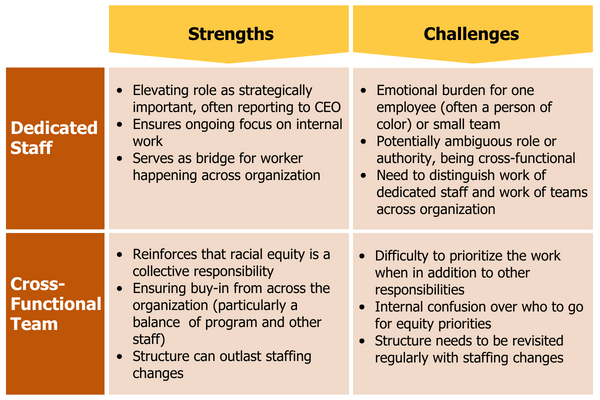The James Irvine Foundation, like many funders, was jolted to act in 2020 after George Floyd’s murder and the ensuing national racial reckoning. Although Irvine had long supported organizations focused on racial equity and had some internal efforts focused on diversity, equity, and inclusion, the Foundation recognized that rising to the moment required more intentional internal work to advance racial equity in the organization’s programs, operations, and investments.
In the following years, Irvine committed to building a shared understanding of racial equity across its board and staff. This helped build alignment around a case statement in 2022 that articulates the Foundation’s beliefs and guides its governance and accountability on specific commitments to address structural racism.
ProInspire — a nonprofit that works with individual leaders and organizations to advance racial equity and justice — supported Irvine staff and leadership with training and coaching during this period. Irvine’s next step was to develop an internal infrastructure for its racial equity work in 2023 and beyond, referencing lessons from other foundations.
Gathering Best Practices from Fellow Funders
To do so, we interviewed five funders (William and Flora Hewlett Foundation, The Kresge Foundation, The California Endowment, San Francisco Foundation, and Weingart Foundation) that made public organizational commitments to racial equity, beyond grantmaking. We wanted to understand how each had strengthened leadership, built staff capacity at all levels, increased accountability, continued learning, and shaped culture to operationalize racial equity and racial justice.
These interviews highlighted three critical components for internal racial equity infrastructure:
- Shared understanding: a framework and clear goals to align stakeholders across the foundation.
- Dedicated internal capacity: staff who have internal trust and credibility to coordinate this work across the foundation, through dedicated staff or cross-functional teams.
- Resources: dedicated resources for ongoing learning and skill-building to support organization-wide progress.
Shared Understanding
All of the foundations we interviewed have a racial equity framework and/or established goals that anchor internal and external work, align stakeholders across the foundation, and help leaders consistently champion racial equity priorities with their teams. However, foundation approaches varied based on its priorities.
The California Endowment (TCE) is developing principles and practices to support department-level shifts toward anti-racism informed by ongoing staff learning. “The foundation works with Resmaa Menakem, American author and psychotherapist who focuses on the effects of trauma on the human body and the relationship between trauma, white body supremacy, and racism in America,” said Director of Racial Equity Practice & Culture Lauren Padilla-Valverde.
In 2019, the Kresge Foundation officially added equity to its organizational values, and later established a Diversity, Equity, Inclusion, and Justice (DEIJ) framework and launched an internal Equity Task Force. This team supports overall organizational learning and skill development and helps shape institutional policies, directives, and practices. They meet regularly to advocate for and assess how equity shows up in Kresge’s grantmaking and operations.
“Our DEIJ framework is an organization-wide tool used internally and externally to drive our quest to operationalize equity in everything we do as a funder, an employer, a staff community, an economic entity, and a citizen within the communities that we serve,” shared Jennifer Jaramillo, chief talent officer at The Kresge Foundation
Dedicated Internal Staff Capacity
The foundations we interviewed agreed that internal leadership focused on coordinating racial equity work across the foundation is important for consistency, learning, and accountability. There were two distinct models: dedicated staff or a cross-functional team.
In both models, internal trust and credibility were important for people responsible for sustaining a long-term infrastructure for racial equity work. The internal leads focused on building organizational culture, coordinating learning, and supporting implementation for racial equity work.
Four of the foundations we interviewed had at least one dedicated director- or manager-level role to support equity, racial equity, and/or DEI work. In most cases, these were internal hires with relevant experience, strong credibility, and trusting relationships across the foundation.
Padilla-Valverde previously spent 12 years at TCE as senior program manager, where she prioritized healing and racial justice by investing in the leadership of those most impacted by inequities. This experience gave her the knowledge and relationships for her role now, which includes connecting racial equity work across TCE, working with the executive team, human resources, staff, and the board.
Three of the foundations we interviewed had a cross-functional team to coordinate racial equity work. For example, The Kresge Foundation has an Equity Task Force and an Equity Planning Group. The Equity Task Force serves as a coordinating group and learning hub, and the Foundation’s executive team identifies members to ensure representation across the foundation. The smaller Equity Planning Group stewards the overall journey. This is also the approach that The James Irvine Foundation has taken in its next phase of implementation.
In both approaches — dedicated staff or a cross-functional team — we heard consistent themes around internal capacity needs:
- Relationships with staff across the foundation are critical.
- The ability to navigate multiple roles, since equity leads often become informal counselors for staff.
- Boundaries for those leading equity work, since leads felt overstretched, regardless of foundation size and structure.

Resources for Learning and Skill Building
Dedicating resources for ongoing learning and skill-building is the final, key aspect of internal infrastructure. We consistently heard the importance of full-staff engagement, and foundations invested in a variety of approaches, from dedicated staff time for learning to hiring consultants and coaches.
Nearly all the respondents organize regular staff learning or training sessions, with the racial equity staff/committee guiding the topics and focus areas. Occasionally, consultants identify learning topics, and sometimes the foundations conduct knowledge sharing and staff-facilitated sessions.
For example, the San Francisco Foundation (SFF) has built a robust learning infrastructure, led by the chief of staff and the organizational development director, which includes monthly learning for everyone in the organization, targeted learning for supervisors and leadership, and onboarding for new employees.
Many foundations also invested in mandatory individual and/or collective coaching for leadership teams. In foundations with a dedicated equity lead or team, they often provide direct technical assistance and coaching internally.
For example, Hewlett Foundation used a liberatory design approach to create a framework that blends learning presentations (from academia) and consulting (from leadership development) for consistency across teams and an outside facilitator/coach for support and reinforcement. An Advisory Group with external and internal participants brings grantees into the work. The learnings are stored to help teams hold themselves accountable. All Hewlett staff also have access to a personal DEIJ coach to support their individual learning, and 30 percent have engaged a coach.
Coaching has also been important for the Weingart Foundation’s racial justice work. After an initial test with leadership, all staff are offered six months of coaching, with the option to extend. Staff note the transformation in themselves and others by showing up more authentically, sharing their voice, and working through tension. Weingart has also established a Design Team to help shape learning at both the staff and board level, work with consultants to operationalize the work, and recommend process and practice changes within the organization.
Foundations must continue to operationalize their commitments to racial equity and racial justice. Foundations play a unique role, given their impact through grantmaking, operations, investments, and influence. To shift work and advance racial equity, it is critical for foundations to continue to ensure a shared understanding around racial equity priorities, dedicate internal capacity, and allocate resources for ongoing learning and skill-building.
Going Deeper: Building Racial Equity Working Groups
Nearly all the foundations we met with utilized cross-organizational racial equity working groups. In some cases, these working groups are the coordinating body, and in other cases they advise dedicated staff who coordinate the racial equity work. Some lessons for creating internal racial equity working groups include:
- Consider representation from multiple departments, levels of authority, and identities (race, gender, etc.).
- Ensure group leads regularly engage with the executive team. In many cases, at least one executive team member is part of the racial equity working group.
- Build out decision-making protocols within the group to address power dynamics.
- Ensure group members have the capacity to serve and that the work is integral to one’s job responsibilities.
- Provide resources and project management support for the group.
- Clarify boundary and authority of the group to make decisions or advise on decisions, such as amount of organization-wide staff time dedicated to racial equity learning.
Monisha Kapila is founder and former Co-CEO of ProInspire and Rajib Guha is director of program development at The James Irvine Foundation.


